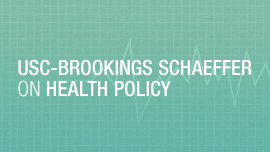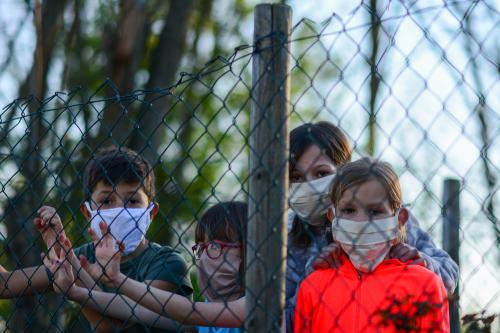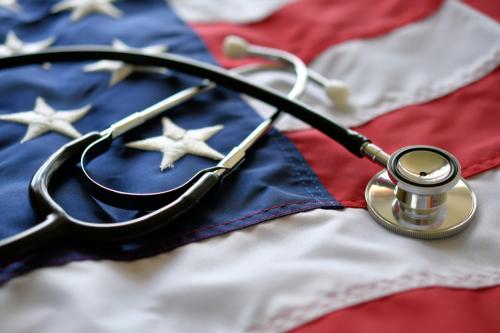This blog post is part of the USC-Brookings Schaeffer Initiative for Health Policy, which is a partnership between Economic Studies at Brookings and the University of Southern California Schaeffer Center for Health Policy & Economics. The Initiative aims to inform the national health care debate with rigorous, evidence-based analysis leading to practical recommendations using the collaborative strengths of USC and Brookings. This work was supported in part by The Commonwealth Fund.
President Biden’s State of the Union address brought renewed urgency to the challenges of treating and supporting people with mental illnesses in the U.S. His proposals respond to escalating rates of mental illness in the U.S., address several vexing long-term issues in mental health care, and deal with some contemporary dimensions of mental illnesses.
The basis for the mental health policy proposals offered in the State of the Union Address are grounded in a set of core values that started with President Kennedy and were extended by President Carter’s President’s Commission on Mental Health, President George W. Bush’s New Freedom Commission, President Clinton’s Report of the Surgeon General on Mental Health and President Obama’s Affordable Care Act reforms. Each of these efforts have moved the nation toward goals that were articulated in a speech by John F. Kennedy’s in 1963, which included key commitments:
“to bestow the full benefits of our society on those who suffer from mental [illness];
to prevent the occurrence of mental illness […] wherever and whenever possible;
to provide early diagnosis and continuous and comprehensive care in the community of those suffering from these disorders;
[and] to reinforce the will and capacity of our communities to meet these problems”
While progress has been made in the decades following President Kennedy’s policy “to-do list,” there is much unfinished business and new challenges created by an evolving society and ecosystem. President Biden’s proposals focus on long-standing problems such as access to care, treatment capacity, and the criminalization of mental illness. They also establish mental health as a key component of the nation’s health care system. President Biden takes on more contemporary challenges such as the rising prevalence of mental illnesses especially among adolescents and young adults, the impact of and potential of digital technology, and the elevated mortality rates among people with serious mental illnesses. Finally, the President seeks to address an enduring challenge that has for too long gone unrecognized and unaddressed: advancing equity in access to and the receipt of quality care. This focus has the potential to relieve the inequitable burdens of mental illnesses that are borne by people of color and economically disadvantaged populations.
The Biden plan proposes to apply a wide range of policy tools that build on prior gains stemming from improved health insurance and innovations in technology and medical science that have expanded understanding of mental illnesses. The Biden plan promises to build on clear eyed assessments of where we have come up short and to make policy changes and investments based on those evaluations. In addition to the priorities described above, the Administration takes steps to address the criminalization of mental illness and the failure to ensure that people with mental illnesses can receive quality health and mental health care regardless of the door through which they enter the health system.
President Biden committed to addressing the first in a generation rise in the prevalence of mental illness that is largely the result of sharp rises in depression among youth and young adults. This trend has been amplified by the COVID-19 pandemic. After being relatively constant for decades, the prevalence rate of mental illness for adults aged 18 and older has increased from 18.3% in 2016 to 21% in 2020, a change of nearly 15%. That increase was largely driven by the increase in the prevalence rate for young adults aged 18 to 25.
Even before the pandemic, there was a crisis in mental health for youth. Among high schoolers in 2019, 1 of every 3 students reported persistent feelings of sadness and hopelessness and 1 in 5 reported seriously considering suicide. Significant inequities exist in the distribution and treatment of youth mental illness related to systemic inequities and individual discrimination experienced by youth. Prevalence of depression and suicide are drastically elevated for LGBTQ+ youth. Racial and ethnic minority youth have less access to mental health care and are more likely to face punishment or criminalization rather than treatment.
The Biden plan seeks to address the unmet need for mental health treatment and the highly variable access to care across different segments of the population in need. Overall, 45% of people with a diagnosable mental illness receive treatment in a year. Treatment rates are notably higher among people with greater illness severity, at 65% for people with serious mental illnesses (SMI). Older adults with mental illnesses are treated more often than young adults; with 73% of people 50 and older with SMI receiving treatment compared to 58% of people 18-25 with SMI. People of color receive care at lower rates. While approximately 69% of white people with SMI received mental health care, for Black, Hispanic, and Asian people with SMI the rates were 55%, 56%, and 44% respectively.
The State of the Union noted that people with serious mental illnesses are at significant risk of experiencing crises. Suicide is the 10th leading cause of death in the US and the rate of suicide increased 35% between 1999 and 2018. The circumstances of people facing behavioral health crises are too often met with law enforcement responses. The results can lead to violent confrontations, unnecessary incarceration, and exacerbation of mental distress. The burden on people with mental illness and for people of color is extremely high. Approximately a quarter of deaths from encounters with law enforcement involved people with signs of mental illness. Black Americans are killed by police more than twice as often as white Americans, regardless of mental health status. Building a continuum of care that focuses on supporting people in mental distress rather than criminalizing or harming them is the focus of current efforts on behavioral health crisis response.
Recent progress sets the stage for next steps
While policy action is urgently needed, it can build on a mental health policy platform that has been developed, largely on a bipartisan basis, over time. Four recent developments in particular form important building blocks for new policy making.
- The Domenici-Wellstone Mental Health Parity and Addiction Equity Act of 2008 (MHPAEA) and the Affordable Care Act (ACA);
- Increased investment and higher standards for a segment of the behavioral health safety net, Certified Community Behavioral Health Centers (CCBHCs);
- The emergence of a strong consumer movement and the recognition that consumers can play an important role in treatment and supports of people with serious mental illnesses;
- The creation of a national mental health hotline (988) and a new financing vehicle for mobile treatment responses to mental health crises.
The combined effects of MHPAEA and the ACA established in law fairness in coverage between medical-surgical benefits and insurance coverage for care of mental illnesses and substance use disorders. MHPAEA set out the requirements that insurance coverage and management of care for mental illnesses and substance use disorders offered by large employers be provided on the same terms as medical-surgical treatments. The ACA extended those requirements to individual and small group insurance plans. That has resulted in important improvements in the cost sharing and extent of coverage (by elimination of coverage limits on services). Specifically, there has been equalization of cost sharing provisions between mental health services and medical surgical coverage. There is also evidence of expanded use of services associated with the parity provision stemming from MHPAEA and the ACA. Yet, as recent assessments from the Department of Labor have shown, there are important aspects of care management and control of access to care in the health insurance industry that do not comply with neither the intent nor the letter of the laws and the implementing regulations.
The 2014 Excellence in Mental Health and Addiction Treatment Act sought to reinvigorate the behavioral health safety net by investing in community-based specialty mental health organizations, CCBHCs, that meet important standards that position them to provide a range of key services at a high level of quality. CCBHCs continue to expand and develop. The existing evidence from evaluations of the program indicate that the on-going development of these safety net providers must evolve to do more to improve the quality of community-based services. Because the initial infrastructure standards to qualify for financial support were quite high, the organizations serving people with mental illnesses in disadvantaged communities frequently could not qualify for financial support under the CCBHC program. Thus, there is unfinished business related to broadly strengthening community mental health services in a fashion that takes special care to promote investment into the most disadvantaged communities.
The consumer movement in mental health began to blossom in the 1980s. Since then, the scientific enterprise (NIMH) and policy makers in federal, state, and local governments have included the voices and ideas originating from consumers and their families in their policy making on a more regular basis. Today, there are dozens of organizations that advocate on behalf of consumers of mental health care and supports. They touch all three branches of the federal government and are active in all 50 states and in hundreds of communities across the country. The engagement of consumers, however, has extended well beyond policy and service advocacy. There is now a recognition of an important role that consumers can play in the process of mental illness recovery in the form of care navigation, peer supports, and care giving. As such, consumers are becoming an important human resource for the mental health care delivery system. Forty years ago, this was largely unheard of. Today’s unfinished business is ensuring that the full set of diverse consumer voices, including people of color, are heard and participate equally in policy, advocacy, and the delivery system.
In July 2022 a new national mental health crisis line will go into effect opening up a new pathway to deploying assistance to people experiencing a behavioral health crisis. Currently, there is a large effort underway to implement this new service that involves multiple federal agencies, state government and, perhaps most importantly, local communities. This includes the complex process of establishing 24/7 call centers with the ability to connect people to help. Additionally, these systems must have the capacity to facilitate connections to specialty behavioral health resources that can stabilize people in crises. A recent law that provides advantageous matching terms for Medicaid funding of mobile treatment services for behavioral health crises represents an important step towards building the requisite capacity that can complement the new 988 call line.
The Biden approach
In the State of the Union, President Biden highlighted key behavioral health issues as priorities and called on Congress to send relevant bills to his desk. We describe major components of the proposals, grouping them into strengthening entry and treatment, expanding community services, strengthening workforce, addressing youth mental health, integrating behavioral health into primary care, expanding access to crisis services, and avoiding justice involvement. We also identify some of the proposals that have been made in Congress to advance policies that are similar to those that the Biden-Harris Administration has proposed. The majority of these proposals have been supported on a bipartisan basis and, significantly, many leaders of the Congressional committees with jurisdiction over these policies have already committed to advancing legislation on a bipartisan basis this year. Doing so would continue a longstanding tradition of bipartisanship on these issues.
Strengthening entry and continuation of treatment
The recent Department of Labor Report to Congress highlighted how MHPAEA and related provisions in the ACA have been incompletely implemented. Existing evidence shows important improvements in the terms of coverage. That is between 65% and 90% of health plan insurance benefits included limits on the number of outpatient visits and inpatient days in the pre-MHPAEA period, such limits have almost completely disappeared.
But the report to Congress also underscores the unfinished business of regulating the management of mental health and substance use disorder care under MHPAEA. Although explicit number limits on mental health services have been largely removed, a number of other barriers to access to mental health and substance use services have not. The management of care often remains more stringent for mental health and substance use services than for physical health services when it comes to the process and methods that insurers and providers use to control utilization; this is inconsistent with MHPAEA and its regulations. The President is proposing expansion of support for efforts to monitor and enforce compliance with such utilization methods, which in the language of MHPAEA are referred to as “Non-Quantitative Treatment Limitations.” The President specifically takes aim at a key aspect of health plans that can limit the availability of mental health care, which is the size and composition of the plan’s provider network. Ensuring access to in-network providers is necessary, whether those services are physical or behavioral in nature. However, a key policy making and implementation challenge will be how to measure adequate network access. Key questions include whether to use metrics such as numbers of professionals in a network or indicators of consumers’ ability to obtain treatment in-network. The President’s parity enforcement policy thrust aligns with two bills that seek to expand activities and authorities for MHPAEA enforcement. These are the Parity Implementation Assistance Act (S.1962) and Parity Enforcement Act (H.R.1364).
A second policy initiative involves expanding the options available to use tele-mental health care technologies. During the COVID-19 pandemic, a substantial share of behavioral health services were delivered through telemedicine. Expanded use of telemedicine offers opportunities to improve access to behavioral health services in several ways. First, the supply of behavioral health providers is highly geographically localized. During the pandemic, states and the federal government made it easier for providers to offer services across state lines. Over a long period of time, it has proven very difficult to increase the supply of mental health providers in geographically isolated areas. The President’s policy direction builds on temporary measures that were established in the urgency of ensuring access during the public health emergency and extends an offer to work closely with the Congress to encourage the continued development of the policy environment that would support the use of tele-mental health to better connect people in need with treatment and supports. The Congress has already taken the step of extending Medicare flexibility with respect to telehealth for five months.
Telehealth can also reduce access barriers by reducing the time-cost to individuals of using counseling and psychotherapy services, which often require frequent visits, especially at the initiation of treatment and during crisis periods. The Biden approach also appears to in part focus designing reimbursement for telehealth that facilitate such access. Finally, telehealth may enable new forms of coordinated physical and mental health care. It will be important to ensure that payment policy enables diverse forms of care and promotes greater use of tele-behavioral health in rural areas. This is especially the case since traditional forms of tele-mental health care have not been built for people from minority cultures, who speak languages other than English, and/or have varying levels of education, who may use these services differently. Congress is currently considering several legislative proposals that touch on tele-mental healthcare. These include: the Tele-mental Health Care Access Act of 2021 (S.2061); the Telehealth Improvement for Kids’ Essential Services (TIKES) Act (S.1798); and the CONNECT for Health Act (S.1512). All these legislative proposals are strongly bipartisan.
Expanding the availability of mental health services in communities
For decades, the U.S. has struggled to make mental health and addiction services available in communities, close to where people live, work, and recreate. In the 1960s, President Kennedy made an expansion of community mental health services a major piece of his mental health policy commitments, which aligned with his determination to dramatically reduce reliance on institutional mental health care. But the reality of available community services has fallen far short of the potential identified more than sixty years ago. Financing challenges, including significant budget cutbacks in the 1980s, workforce shortages, and waxing and waning levels of attention and commitment to community services at the state and federal levels have hindered progress. While the challenge of making services more available remains, so does the clear potential of convenient, high quality community services to decrease rates of unmet mental health needs and strengthen quality service provision by increasing access. Community mental health services may also reduce reliance on some of the default, higher cost mental health settings, including hospitals and jails, the latter of which are problematic service settings that are generally not well equipped to meet clinical needs.
The Biden-Harris Administration would deploy multiple mechanisms to expand access to community services. The Administration’s proposals rely on two existing programs, CCBHCs, which began as a demonstration program that Congress has extended and expanded several times, and community mental health centers (CMHCs), but also go well beyond them. Significant new funding is proposed for grants to strengthen the delivery of mental health services generally, as well as to specifically expand behavioral health provider capacity in Medicaid. The Administration proposes to pilot innovations in the settings in which people can receive mental health services, including schools, community centers, and libraries, and to equip housing and social service providers to identify and respond to mental health issues.
Efforts to expand community services may help address significant inequities. People and communities of color have historically had lower rates of service use and higher rates of unmet service needs than have white people. In addition, people of color express concerns about stigma, prejudice, and discrimination in traditional health care settings. Legislation, such as the Pursuing Equity in Mental Health Act (S.1795), has been introduced in Congress to increase access to mental health resources in racial and ethnic minority communities.
Ensuring ongoing coverage and financing will underpin the provision of community health services over the long term. To that end, the Administration would for the first time authorize Medicare to cover services provided by counselors, therapists, and community health workers. This is a significant expansion in the types of providers who are available under Medicare to provide behavioral health services including peers. Additional attention to financing behavioral health services in Medicaid, where availability of covered services and provider acceptance is associated with relatively low beneficiary access to services, could help ensure that any new state and federal investments in provider capacity are sustained over time. Proposed legislation, the Turn the Tide Act (S.1010), would put Medicaid rates for behavioral health services on a par with those that Medicare pays.
Strengthening and diversifying the workforce
Creating an adequate and equitably distributed workforce is central to promoting access to services. Mental health professionals are widely perceived as being in undersupply. However, workforce estimates vary greatly, challenging a precision in the extent of supply deficits and the variation by type of provider. There are an estimated 6,223 mental health provider shortage areas in the US currently; even this type of estimate, which is derived from fixed ratios of professionals to population, frequently fails to recognize the overlapping skills and capabilities of various professions and thus overlook substitution capabilities. One result is that different agencies produce widely varying estimates of shortages.
Nonetheless, the data are clear that there is a maldistribution of the workforce with shortages in some locations and under some organizational arrangements. Low income and rural communities are especially prone to facing significant rates of unmet need for services. In addition, lack of diversity and cultural competency in the workforce means that services may disproportionally fail to meet the needs of people from minority communities. It is also the case that some professional groups such as psychiatrists and psychologists have very low rates of participation in health insurance programs, including Medicaid. That creates access barriers because most people with insurance do not have the means to pay fully out of pocket. In these cases, the appearance of a shortage is as much due to payment policies and failure to fully enforce MHPAEA provisions that network design policies should be no more restrictive for behavioral health services than they are for other medical care. Both payment and network design affect the in-network supply of professionals.
Historically, a key federal policy workforce lever has been federal loan repayment and related workforce development programs. Like many preceding Administrations, the Biden-Harris Administration proposes to expand these central tools, including the National Health Service Corps and Behavioral Health Workforce Education and Training Programs, which trains a range of behavioral health clinicians and aims to specifically address areas with significant unmet need for providers. The Biden proposals build on a growing appreciation for the capabilities of non-doctoral trained professionals. The President proposes to increase investment in the Minority Fellowship Program, which seeks to improve patient outcomes by increasing racial and ethnic minority representation in the behavioral health workforce and training practitioners to serve a diverse patient population. Congress is paying significant attention to workforce issues. Relevant legislation includes: Mental Health Professionals Workforce Shortage Loan Repayment Act (S.1578), to expand loan repayment; the PEERS Act (H.R.2767) and the Veteran Peer Specialist Act (S.2386), to advance peer supports; and the Strengthening Mental Health Supports for BIPOC Communities Act (H.R.1331), to collect data on services provided to communities of color.
Addressing the growing rates of mental illnesses among youth
Addressing youth mental health was a substantial focus of the State of the Union. The Biden-Harris Administration has previously supported school-based mental health services through use of American Rescue Plan relief funds. Early intervention is crucial for prevention and to reduce the progression and severity of mental illness, decreasing the burden of disease on both community and individual levels. Increasing access to services requires developing systems of care need to meet children where they are. Schools can serve as a critical intervention point. School-based services offer access and early response and must be equipped with adequate and appropriate resources to meet the needs of students and staff. Such services can include hiring mental health professionals to work in schools, training school personnel on screening, early-recognition, and response for mental health issues among students, and connecting students to community-based care providers.
To build on ongoing efforts, the President proposes to increase funding by $1 billion to further support the hiring of mental health professionals in schools and double the number of school-based mental health providers. He has also prioritized strengthening the role Medicaid plays in supporting school health services by committing to new guidance and directing the Departments of Education and HHS to provide technical assistance to schools towards developing Medicaid-covered school mental health services.
The President also proposed dedicating funding to infant and early childhood mental health efforts and community schools that offer wraparound services. The Administration also announced new policies and resources concerning youth and social media, including funding to research potential clinical and societal interventions to address social media harms and launching the Center of Excellence on Social Media and Mental Wellness. In Congress, legislation has been proposed to increase funding for school-based mental health services and suicide prevention training, including the Mental Health Services for Students Act (S.1841) and the STANDUP Act (S.1543). Legislation also aims to specifically address mental health issues for racial and ethnic minority youth, the Pursuing Equity in Mental Health Act (H.R.1475), and to shift funding away from law enforcement in schools towards social workers and counselors, the Counseling Not Criminalization in Schools Act (S.2125).
Integrating mental health and other medical care
Although research has demonstrated that well integrated care in PCP practices can be cost-effective and greatly increases the nation’s capacity to treat mental illnesses, the U.S. has long struggled to integrate treatment for mental illnesses and substance use disorders into primary care. Roughly 50% of people with a mental health problem seek treatment from a PCP. PCPs are often reluctant to recognize and treat mental illnesses. People with serious mental illnesses die prematurely too often. Much of that comes from neglect of medical conditions that stem from deprivation and/or are iatrogenic. Too often these medical illnesses are not attended to by specialty mental health providers. Integrating behavioral health care and primary care is an effective strategy to improve screening, treatment delivery, and care coordination for patients. The Biden-Harris Administration proposed to double funding for behavioral health integration programs.
Researchers and clinicians for many years advocated for specialized payment codes to recognize the extra time and unique challenges encountered in treating depression and other mental illnesses in primary care settings. Likewise, payment restrictions in the Medicare program were posited to stand in the way of implementing models of care that were shown to be both effective and cost-effective. Specifically, these restrictions only permitted a single visit per day from a practice to be reimbursed under Medicare Part B. The Biden-Harris Administration is seeking to ensure that more than a single visit per day can be billed in Medicaid to preempt limits that are inconsistent with evidence-based integration efforts. The Obama Administration addressed some of these barriers to integration and those changes failed to produce the desired results of substantially greater integration of behavioral health into primary care practices. Evidence from that experience alongside a demonstration conducted with support from the Robert Wood Johnson Foundation suggests that to improve the likelihood of more integration, policy must motivate changes in the workflow of primary care practices, which is more complicated than modest adjustments to payment codes and billing rules. The Administration seeks to pursue a strategy that establishes payment systems that promote integration. Experience suggests such payment systems might be most effective if they link payment and performance measures that combine to reward evidence based treatment and successful integration of mental health and other medical care across key public payment systems like Medicare Advantage, the Medicare Shared Savings Program, Medicaid Managed Care Organizations and the Health Insurance Marketplaces. Congress is currently considering grants to support integrating behavioral and primary care with the bipartisan Collaborate in an Orderly and Cohesive Manner Act (H.R.5218).
Meeting the needs of people when they face behavioral health crises
Increasing rates of acute mental health and substance use conditions, and in particular accelerating rates of suicide, are driving federal policy changes as well as policy and operational changes at the state and local levels. The data on youth suicide are especially troubling. Data from the National Household Survey on Drug Use and Health reports that in 2020, 12% of people aged 12 to 17 had suicidal thoughts and 2.5% attempted suicide. As noted earlier, people who are facing behavioral health crises, when their condition is acute and necessitates an immediate response, often experience interventions that involve law enforcement and 911, rather than accessing behavioral health services. The result is a system that relies disproportionately on jails and hospital services and contributes to people with mental illness and Black people experiencing high rates of police violence and incarceration.
Policy and operational attention to these issues over the past year has been unprecedented. The most significant change involves the implementation of a universal number, 988, that people experiencing mental health crises can call for help and to connect to services. When 988 implementation takes effect, it will build out an existing National Suicide Prevention Lifeline that exists in many parts of the country. 988 can and should connect people who are experiencing mental health conditions to services. SAMHSA has, in national guidelines, defined the key elements of behavioral health crisis response as the capacity to call, an immediate service response, and ongoing connection to services, if they are needed. In addition to 988, which is significantly expanding call capacity, more than half of states plan to take up a new Medicaid financial incentive established in the American Rescue Plan to adopt mobile crisis services by creating new or expanding existing mobile crisis programs.
SAMHSA estimates that 7.6 million people will call 988 in 2023, more than triple the number of calls that were made in 2020. To respond to this need, the Administration proposes an increase to $697 million in funding for 988 call centers from current funding levels of $180 million. The Administration also proposes to double the share of mental health block grant funding that states must dedicate to crisis services and is dedicating resources to expanding 988 crisis line and suicide prevention for veterans.
These additional resources will make a modest contribution to closing a significant gap in the funding that is needed to build a comprehensive continuum of crisis services. Some legislative proposals, and in particular the Behavioral Health Crisis Services Expansion Act (S.1902), take a far more expansive approach to building the crisis continuum, by requiring Medicaid, Medicare, and other insurers to cover crisis services and developing standards for such services. Legislation to strengthen 988 implementation has been introduced in Congress, including the Mental Health Justice Act of 2021 (S.515) and the 988 Implementation Act (H.R.7116).
Helping people with mental health needs avoid justice involvement
People with serious mental illnesses are overrepresented in the criminal justice system. Although the prevalence of serious mental illness in the general population overall is about 5%, estimates suggest that 26% of people in jails and 14% of prison inmates have a serious mental illness. Incarceration rates for Black and Hispanic Americans are respectively 5 and 1.6 times those of white populations. The reasons for this are varied and include difficulty accessing mental health services prior to incarceration. Expanding behavioral health crisis services has potential to help people avoid jails and prisons and can help address extremely poor health outcomes that people face after release. Policies are also needed to promote access to services when people are released from prisons and jails to help people rejoin their families and communities and avoid returning to jail or prison. Recognizing that prisons and jails are the largest mental health provider in some communities and parts of the country and describing a “moral and public health obligation to increase access to comprehensive mental health care,” the Administration proposed to expand resources through the Department of Justice to provide behavioral health and other services for people returning to communities after incarceration. Congress has been actively considering legislation, the Medicaid Reentry Act (H.R.955), to advance the health of people as they prepare to leave prison and jail by for the first time by requiring Medicaid to cover services in the 30 days prior to an individual being released from prison or jail. This legislation, which passed the House of Representatives as part of last year’s Build Back Better package, has potential to increase access to needed mental health, substance use, and care coordination services as people leave incarceration and return to communities. Nine states have also made proposals to HHS to make similar policy changes through demonstration waiver authority.
Concluding remarks
The President’s State of the Union Address and the Budget he submitted to Congress is striking in its ambition to comprehensively address the challenges posed by mental illness in America. The proposals for improving mental health care in all corners of the U.S. represent both a recognition of the unfinished business of existing mental health policy and responses to new problems. It is attentive to new possibilities for improved care offered by evolving technologies and previously untapped human resources. However, addressing longstanding and new challenges in mental health will require significant additional action by Congress and substantial attention from policymakers, advocates, consumers, and providers over time. Taking the high-level proposals to ground will require mobilizing stakeholders, professionals, state and local governments, and many federal agencies and bureaus. Legislation, administrative action, persuasion, and focused use of the bully pulpit will have to be mobilized to realize the vision.
Disclosures: Victoria Wachino is an advisory board member and consultant to Mental Health Strategic Impact Initiative. Other than the aforementioned, the authors did not receive financial support from any firm or person for this article or from any firm or person with a financial or political interest in this article. Other than the aforementioned, the authors are not currently an officer, director, or board member of any organization with a financial or political interest in this article.
The Brookings Institution is financed through the support of a diverse array of foundations, corporations, governments, individuals, as well as an endowment. A list of donors can be found in our annual reports published online here. The findings, interpretations, and conclusions in this report are solely those of its author(s) and are not influenced by any donation.
-
Acknowledgements and disclosures
We are grateful to Stuart Butler and Reginald Williams for helpful comments on a previous draft of this paper. Caitlin Rowley provided excellent editorial and publication support.
The Brookings Institution is committed to quality, independence, and impact.
We are supported by a diverse array of funders. In line with our values and policies, each Brookings publication represents the sole views of its author(s).









Commentary
Tackling unfinished business and taking on current challenges: Putting Biden’s mental health proposals in context
April 4, 2022